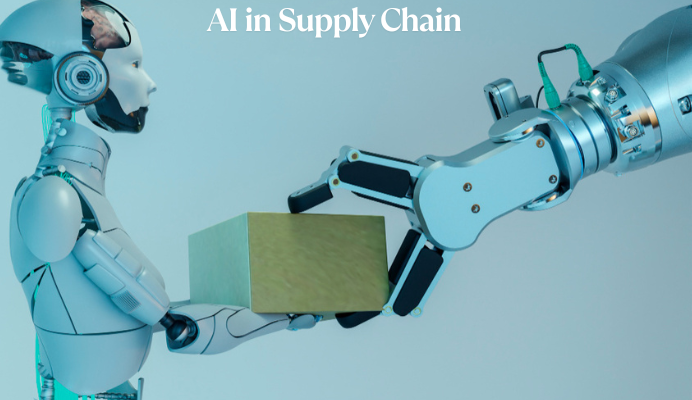
AI in Supply Chain – A Beginner’s Guide
Artificial Intelligence (AI) is transforming the logistics and supply chain industry into a highly efficient, responsive, and data-driven ecosystem. As of 2025, the global AI in logistics market has surged to $20.8 billion, growing at a compound annual growth rate (CAGR) of 45.6% since 2020.
This rapid adoption is fueled by AI’s ability to automate complex decision-making, enhance real-time analysis, and improve supply chain planning. Leading companies illustrate the power of AI in supply chain planning and operations.
For example, Microsoft uses AI to automate fulfillment planning across more than 40 distribution centers, reducing planning time from four days to just 30 minutes while boosting accuracy by 24%.
Businesses leveraging AI are not only cutting costs but also improving customer satisfaction by ensuring products are available when and where needed, making supply chains smarter, more agile, and resilient.
What is AI in Supply Chain?
AI in supply chain is the technology that brings intelligence, automation, and real-time insights to every link of the supply chain—from sourcing raw materials to delivering finished products.
At its core, AI uses advanced algorithms and machine learning to analyze massive amounts of data from different sources such as suppliers, warehouses, transportation fleets, and even market trends, enabling smarter, faster decisions that humans alone cannot match.
How does AI in Supply Chain work?
Artificial Intelligence (AI) plays a key role in supply chain management by enhancing efficiency, responsiveness, and decision-making.
1. Demand forecasting: AI tools analyze historical sales data and market trends to predict future demand. This helps companies adjust their inventory levels and production schedules, accordingly, reducing the risk of overstocking or stockouts.
2. Real-time monitoring: AI systems can monitor supply chain operations in real-time, detecting disruptions such as delays in shipping or production issues. For instance, they can analyze traffic conditions and other logistical factors to provide insights into potential delays.
3. Quality control: AI can identify errors in manufacturing processes by catching mistakes before products are misassembled or sent to incorrect destinations. This capability not only saves time but also minimizes material waste.
4. Root cause analysis: By assessing large volumes of data, AI can conduct root cause analyses to identify correlations that explain failures in the supply chain. This equips teams to implement better fixes more quickly.
5. Safety and compliance: AI can analyze workplace safety data to inform manufacturers about potential risks, ensuring that warehouses and production facilities remain secure and compliant with regulations.
6. Integration with ERP systems: AI is often embedded in Enterprise Resource Planning (ERP) systems, which manage financial transactions and the flow of goods through the supply chain. This integration allows for more streamlined operations.
Challenges of AI in Supply Chain
Integrating AI in supply chain management offers immense potential, but it also comes with significant challenges that organizations must address to achieve success. Here are some challenges and their implications:
1. Securing and retaining skilled talent
The demand for professionals skilled in both AI technology and supply chain operations far exceeds supply. Recruiting and retaining such talent is highly competitive and costly.
Moreover, these experts must also understand the unique dynamics of the organization’s supply chain to tailor AI solutions effectively. Continuous training and development are essential, but not always easy to implement.
2. Data inaccessibility and poor data quality
AI systems rely on vast amounts of high-quality, integrated data from multiple sources—ERP systems, IoT devices, suppliers, and more. However, data is often siloed, incomplete, or inconsistent across departments.
Poor data quality or lack of access limits AI’s ability to generate accurate insights and predictions, reducing its effectiveness and leading to suboptimal decisions.
3. Functional silos
Departments within organizations frequently operate in isolation, resulting in fragmented data and knowledge. This siloed approach prevents AI from accessing comprehensive, cross-functional information and its needs for holistic analysis and optimization. Overcoming these silos requires cultural and process changes to foster collaboration and data sharing.
4. Legacy systems and integration challenges
Many organizations rely on outdated legacy systems that are difficult and costly to upgrade. Integrating modern AI solutions with these systems can lead to compatibility issues, workflow disruptions, and data integrity risks. The transition often demands significant investment in time, resources, and technical expertise.
5. High initial costs and budget constraints
Implementing AI in supply chains involves substantial upfront costs for software, infrastructure, and talent acquisition. Ongoing operational expenses, including system maintenance and updates, further strain budgets. For many organizations, especially smaller ones, these financial barriers can be prohibitive.
6. Lack of a clear transformation strategy
Without a well-defined, organization-wide strategy, AI implementation can become misaligned with business goals, resulting in wasted resources and fragmented efforts. A clear vision and roadmap are essential to guide transformation, ensure stakeholder buy-in, and foster a culture of continuous improvement.
7. Short-term focus and resistance to change
Organizations may prioritize short-term gains over long-term transformation, limiting the impact of AI. Resistance to change among employees and management can also hinder adoption. Building a culture that embraces innovation and continuous learning is critical for sustainable success.
8. Complexity and scale of supply chain networks
Modern supply chains are highly complex, with numerous interconnected processes, stakeholders, and variables. Developing AI models that can accurately capture and adapt to this complexity is challenging. The scale and dynamic nature of supply chains require robust, scalable, and flexible AI solutions.
9. Interpretability and trust in AI decisions
AI models, especially deep learning algorithms, are often seen as “black boxes,” making it difficult for supply chain professionals to understand and trust their recommendations. Lack of transparency can lead to skepticism and slow adoption. Explainable AI (XAI) and clear communication are necessary to build trust and accountability.
10. Data security and privacy risks
AI-driven supply chains collect and process sensitive data, increasing exposure to cyber threats and privacy breaches. Protecting confidential information and ensuring compliance with data protection regulations are critical challenges that require robust governance, encryption, and access controls.
Benefits of AI in Supply Chain
An AI-powered supply chain system has many benefits. Let’s look at some of them.
1. Lower operating costs
AI helps reduce operating costs by automating routine tasks, optimizing resource allocation, and identifying inefficiencies across the supply chain. For example, AI-driven route optimization can lower fuel and transportation expenses, while predictive analytics help companies avoid costly overstocks or stockouts. IBM reports saving $160 million in supply chain costs through AI-driven automation and optimization.
2. Advanced real-time decisions
AI processes vast amounts of data from multiple sources—including IoT devices, market trends, and supplier performance—enabling companies to make informed decisions instantly. This real-time insight allows businesses to respond swiftly to disruptions, changing demand, or unexpected events. For instance, AI can detect a supply bottleneck and reroute shipments automatically, minimizing delays.
3. Cut down on errors and waste
By automating data entry, inventory tracking, and other manual processes, AI minimizes human errors and reduces waste. AI’s predictive capabilities ensure that inventory levels are maintained optimally, preventing both excess inventory and shortages. This not only cuts costs but also supports more sustainable operations by reducing unnecessary production and disposal.
4. More tailored inventory management
AI-powered inventory management systems analyze historical sales, lead times, and market trends to recommend precise stock levels for each product. This results in a more tailored approach, ensuring that companies have the right products available at the right time—boosting customer satisfaction and reducing costs.
AI can also adapt to seasonal fluctuations or sudden demand changes, making inventory management more responsive.
5. Improved warehouse efficiency
AI enhances warehouse operations by optimizing storage layouts, automating picking and packing processes, and streamlining workflows. Machine learning models can analyze the flow of goods and suggest the most efficient paths for workers and machinery, reducing idle time and increasing throughput. Predictive maintenance powered by AI also helps prevent equipment failures, ensuring smooth operation.
6. Better supply chain sustainability
AI supports sustainability by optimizing logistics routes, reducing fuel consumption, and minimizing waste. For example, AI can consolidate shipments and select the most efficient routes, lowering carbon emissions.
Additionally, accurate demand forecasting reduces overproduction and excess inventory, further cutting down on waste and supporting environmental goals. The transport and supply chain sector accounts for 25% of global greenhouse emissions, and AI-driven improvements can make a significant positive impact.
Conclusion
AI in supply chain management is transforming how businesses operate by automating routine tasks, improving demand forecasting, and optimizing inventory and logistics in real time. It enables companies to make faster, data-driven decisions that reduce costs, minimize errors, and enhance overall efficiency.
With AI, supply chains gain greater visibility and resilience, helping businesses anticipate risks and respond swiftly to disruptions. Additionally, AI supports sustainability efforts by optimizing routes and reducing waste, making supply chains smarter and more sustainable in today’s dynamic market environment.






